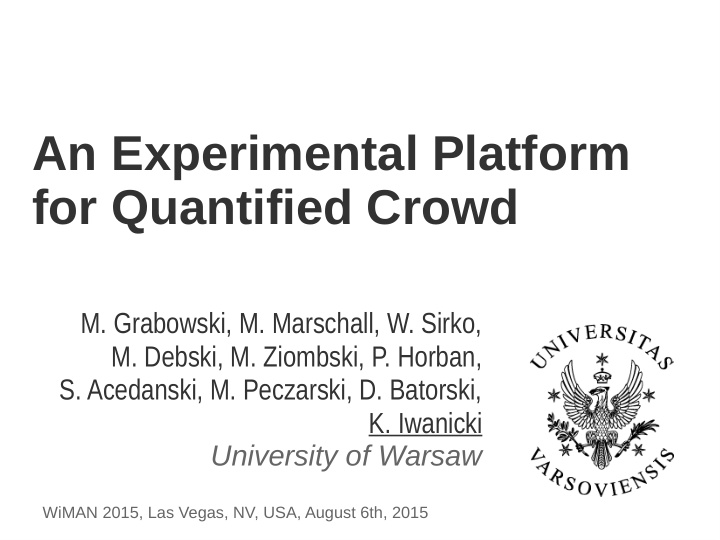



An Experimental Platform for Quantified Crowd M. Grabowski, M. Marschall, W. Sirko, M. Debski, M. Ziombski, P. Horban, S. Acedanski, M. Peczarski, D. Batorski, K. Iwanicki University of Warsaw WiMAN 2015, Las Vegas, NV, USA, August 6th, 2015
Image source: http://www.health2news.com/files/2011/11/WellnessFX-300x220.png You can't manage what you don't measure = Self knowledge through numbers Quantified Self Image source: http://www.peelapom.com/ketzirah/wp- content/uploads/2013/04/bodyMonitor_collage- filtered-1024x800.jpg
Quantified Crowd The enabling factors: adapted from image: http://www.clker.com/clipart-smaller-crowd-rdc.html ● Further device miniaturization; ● Low-power wireless inter- device communication. The core ideas: ● Collaborative sensing of collocated people. ● Online and (partially) in- network data analysis. ● Coordinated feedback for groups of people.
Quantified Crowd Crowd management: Image source: http://en.wikipedia.org/wiki/File:Crowd_in_street.jpg ● Detecting patterns of coordinated behavior in a crowd. ● Automaticly recognizing and predicting problematic situations. ● Notifying people and the autorities about danger. You can't manage what you don't measure
Quantified Crowd Maximizing event Image source: https://pixabay.com/en/music-kiss-rock-heavy-metal-819152/ experience: ● Detecting interpersonal interactions. ● Recognizing communities. ● Navigation through crowds. ● Contact and content suggesting.
Problem Statement Image source: http://electronicdesign.com/content/14978/59382_fig_01.jpg Prior research has been conducted with: ● Smartphones, or ● Custom devices. We are not aware of a common platform that would allow for innovating at various levels of quantified crowd.
Experimental Platform Goal: ● experimentation in as many scenarios as possible. Components: ● Hardware ● Software
Hardware Design goals: ● On its own should enable experimentation in many scenarios. ● It should be possible to extended with external devices.
Hardware Based on ARM Cortex-M0+.
Hardware Local sensors: ● Accelerometer ● Magnetometer ● Gyroscope ● Microphone ● Barometer (altimeter) ● Light sensor ● Thermometer ● Hygrometer
Hardware Crowd texture sensors: ● Low-power 868MHz radio ● Infra-red transceiver ● Bluetooth Low Energy chip
Hardware I/O interfaces: ● 400x300 e-paper display ● Buttons ● LEDs ● Buzzer ● External flash memory ● SD card ● USB socket
Software ● Badge software – written in NesC. ● External software – mostly Java.
Evaluation ● Conducted on a small scale. ● We are in the process of manufacturing a large batch of badges.
Evaluation Power consumption Component Standby [μA] Active [mA] MCU 1.7 6.1 RF transceiver 0.2 16.9 (RX), 34.2 (TX @ 12 dBm) Infrared transceiver 0 0.9 (RX), 72 (TX @ power level 3) BLE module 0.4 25 (RX), 36 (TX) E-compass 2 0.44 Gyroscope 1 5 Barometer 0.5 0.025 Light sensor 4 0.13 Microphone 0 1.8 External flash 100 20 SD card 0 depends on a card (e.g., 100) E-paper display 0 8
Evaluation Proximity detection with RF Radio TX power [dBm] Dist. [m] -30.2 -27.7 -20.5 -15.7 -11.0 -5.0 -0.3 3.7 1 74.8 85.3 99.0 99.7 99.4 99.3 99.7 99.6 2 14.0 65.7 99.7 99.2 99.0 99.6 99.3 98.4 3 2.0 0.0 98.7 98.9 99.3 99.6 99.2 99.3 5 14.9 0.0 99.4 99.1 99.6 99.4 97.9 99.3 10 0.0 0.0 36.0 96.0 99.7 99.9 99.0 99.3 20 0.0 0.0 0.0 14.9 98.3 99.9 99.3 99.5 30 0.0 0.0 0.0 0.0 23.6 35.0 99.0 99.1 40 0.0 0.0 0.0 0.0 20.0 22.0 68.5 99.5 50 0.0 0.0 0.0 0.0 0.0 1.0 11.0 98.8 60 0.0 0.0 0.0 0.0 0.0 0.0 23.4 98.1 70 0.0 0.0 0.0 0.0 0.0 0.0 0.0 0.0
Evaluation Proximity detection with IR IR TX power [level] Dist. [m] 0 1 2 3 1 100.0 99.0 93.0 88.0 2 74.0 67.0 99.0 88.0 3 0.0 55.0 33.0 51.0 4 0.0 0.0 50.0 53.0 5 0.0 0.0 0.0 30.0 6 0.0 0.0 0.0 0.0
Evaluation Mutual orientation detection with IR
Evaluation Real-world situation detection
Conclusion ● Our platform has the potential to serve on its own in various experimental scenarios for quantified crowd. ● It can be extended with off-the-shelf mobile devices, which further broadens its applicability. ● We are in the process of manufacturing 100 pieces of the badges. ● We hope that the platform will be used by other groups.
Thank You Questions? Supported by the (Polish) National Science Centre (NCN) within the SONATA programme under grant no. DEC-2012/05/D/ST6/03582. K. Iwanicki was additionally supported by a scholarship from the (Polish) Ministry of Science and Higher Education for outstanding young scientists.
Recommend
More recommend